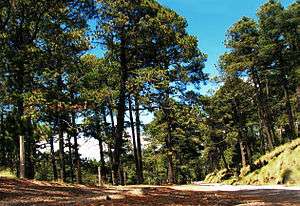Trans-Mexican Volcanic Belt pine-oak forests
| Trans-Mexican Volcanic Belt pine-oak forests | |
|---|---|
|
Popocatépetl, Puebla state | |
 | |
| Ecology | |
| Biome | Tropical and subtropical coniferous forests |
| Borders |
|
| Geography | |
| Area | 91,800 km2 (35,400 sq mi) |
| Country | Mexico (Central) |
| Conservation | |
| Conservation status | Critical/Endangered[1] |
The Trans-Mexican Volcanic Belt pine-oak forests is a subtropical coniferous forest ecoregion of the Trans-Mexican Volcanic Belt of central Mexico.
Setting
_001.jpg)
The Trans-Mexican Volcanic Belt Pine-Oak Forests occupy an area of 91,800 square kilometers (35,400 sq mi), extending from Jalisco state in the west to Veracruz in the east.
The pine-oak forests are surrounded by tropical dry forests at lower elevations to the west, northwest, and south; the Jalisco dry forests to the west and southwest; the Balsas dry forests to the south, in the basin of the Balsas River, and the Bajío dry forests to the northwest, in the basin of the Rio Grande de Santiago and the lower Rio Lerma. The Central Mexican matorral lies to the north of the range in the high basins of the Plateau, including the Valley of Mexico and the upper reaches of the Lerma around Toluca. The Tehuacan valley matorral lies in the rain shadow valley to the southeast in Puebla and Tlaxcala states. To the east, the moist Veracruz montane forests and Oaxacan montane forests are the transition between the pine-oak forests and the lowland tropical forests along the Gulf of Mexico.
Pockets of montane grassland and shrubland can be found among the pine-oak forests, and constitute a separate ecoregion, the Zacatonal.
Flora
The chief plant communities are pine forests, pine-oak forests, oak forests, pine-cedar forests, and pine-fir forests. The plant communities vary with elevation and rainfall.
Pine forests are generally found between 2,275 and 2,600 m. Pine-oak forests occur between 2,470 and 2,600 m. Pine-cedar forests can be found above 2,700 m. Pine-fir forests occur above 3000 m.
In the pine forests, Montezuma Pine (Pinus montezumae) is generally predominant, with Smooth-bark Mexican Pine (P. pseudostrobus) predominant in more humid areas, and Hartweg's Pine (P. hartwegii) and P. tecote in dry areas with shallow soils.
Pine-fir forests are composed almost entirely of Hartweg's Pine (Pinus hartwegii) and Sacred Fir (Abies religiosa).
Fauna
The volcano rabbit (Romerolagus diazi) and the Mexican volcano mouse (Neotomodon alstoni) are endemic to the ecoregion.
Monarch butterflies
The Volcanic Belt pine-oak forests of eastern Michoacán and western México states is the winter habitat of Monarch butterflies (Danaus plexippus), which migrate from temperate regions of North America east of the Rocky Mountains. The Mariposa Monarca Biosphere Reserve is within this habitat.
See also
References
- ↑ "Trans-Mexican Volcanic Belt pine-oak forests". Terrestrial Ecoregions. World Wildlife Fund. Retrieved 2012-11-04.
